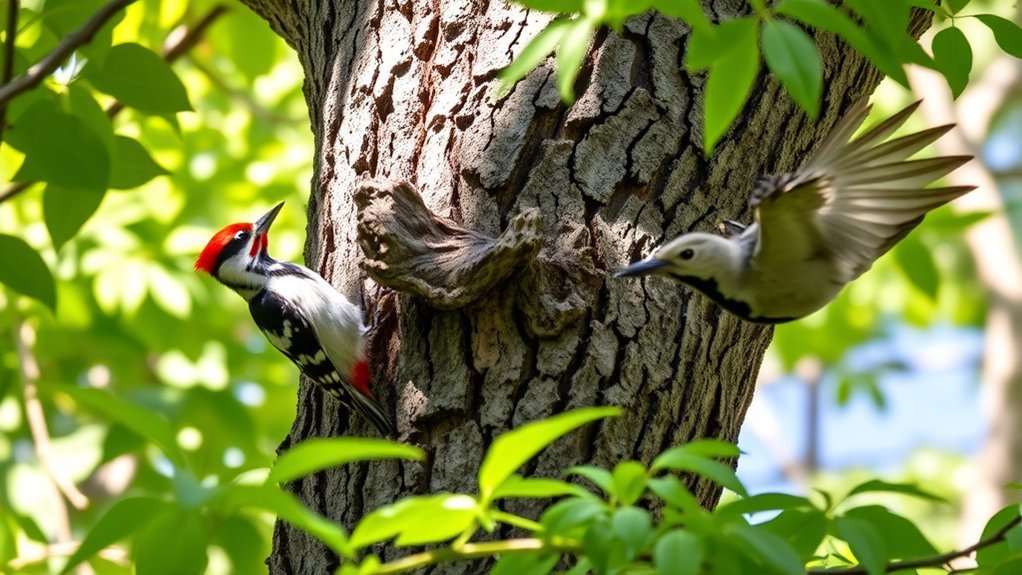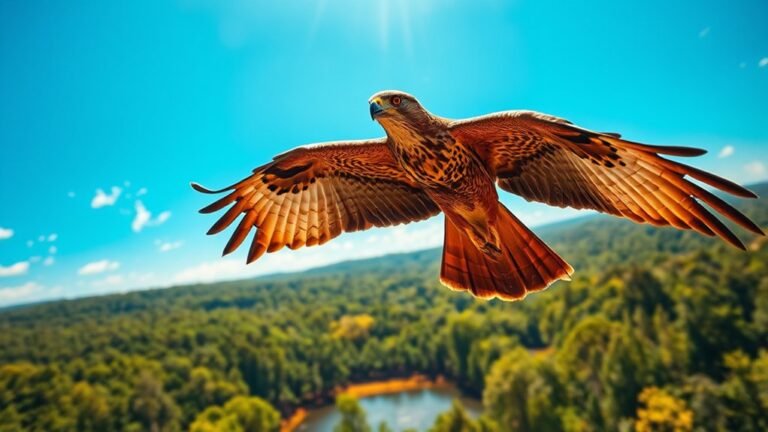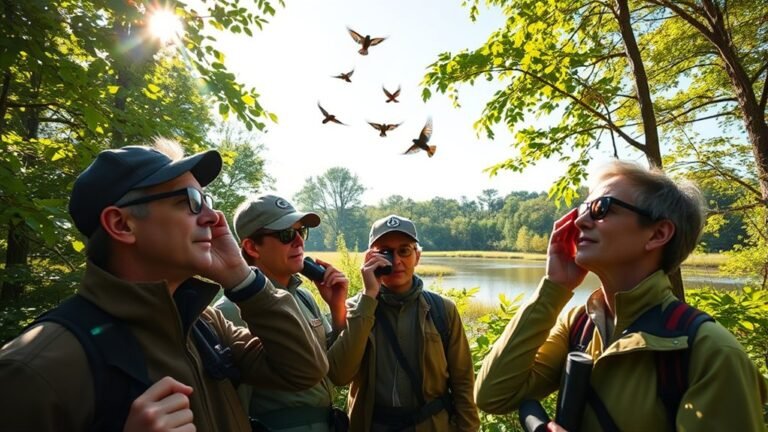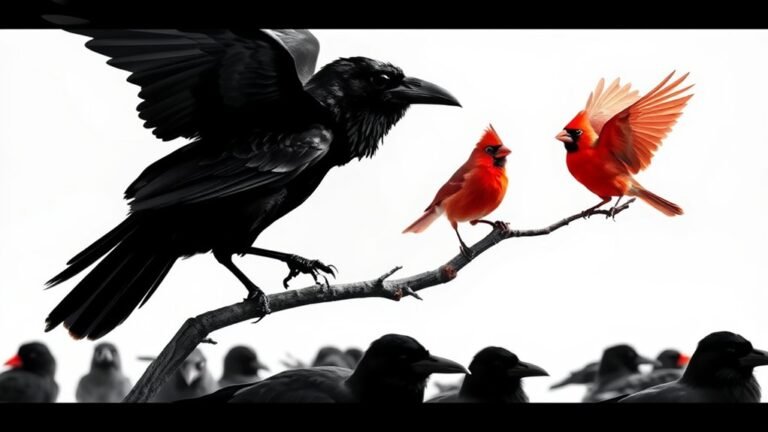Woodpeckers in Tennessee: Identification Guide
In Tennessee, you can find interesting woodpeckers like the Downy Woodpecker and the Red-bellied Woodpecker. They are fun to watch because of their colorful feathers. But identifying them is not just about their looks. You can also listen to their calls and drumming. They make these sounds mostly during dawn and dusk.
Knowing where they live can help you spot them easier. Look for them in wooded areas or in parks. You might also notice what they like to eat. They often feed on insects, so keep an eye out for them pecking on trees.
Lastly, it's good to think about how we can help keep these birds safe and healthy in their habitats. Enjoy watching these amazing woodpeckers!
A Quick Overview
Tennessee has many types of woodpeckers. You can find the Downy, Red-bellied, and Pileated Woodpeckers here. Each type looks a bit different.
To tell them apart, look at their colors, bills, and the sounds they make. These features help you notice which woodpecker you see or hear.
Woodpeckers like to live in places like thick forests, mixed woods, and city parks. These habitats are important for them to find food and build nests.
If you watch how they feed and make their homes, you will learn why they matter in nature.
The best times to see woodpeckers in Tennessee are early in the morning and late in the afternoon. Bring binoculars to see them better without bothering them. Enjoy your woodpecker watching!
Common Woodpecker Species in Tennessee

Tennessee is home to many types of woodpeckers that are important for the local environment. Some of the common ones you'll see include the Downy Woodpecker and the Red-bellied Woodpecker. You can often hear their unique calls echoing in the woods. These sounds help them talk to each other and mark their territory.
Woodpeckers like to build their nests in old or decaying trees. They dig out holes that not only provide a home for themselves but also create space for other animals. These nests are important for keeping the forest healthy.
Learning about woodpeckers can help you see how they contribute to nature in Tennessee. They play a big role in keeping our ecosystems balanced and thriving.
Key Identification Features
When you want to identify woodpeckers, look for some key features that help tell the different types apart. Here are some things to notice:
- Color Patterns: Each woodpecker species has its own colors. For example, the Red-headed Woodpecker is bright red and black. The Downy Woodpecker has a cool white and black pattern.
- Bill Size and Shape: The size and shape of their bills can be different. Some woodpeckers have long, thin bills, while others have shorter, thicker ones. This can help you tell them apart.
- Sound Calls: Woodpeckers make unique sounds. The Pileated Woodpecker has a strong drumming noise, while the Northern Flicker makes quick, sharp knocks.
Pay attention to their calls to help with identification.
Habitats and Distribution

Woodpeckers live in many kinds of places, and these places help shape how they act and eat. You can find woodpeckers in thick forests as well as in quiet city parks.
In Tennessee, different types of woodpeckers, like the Downy and Red-bellied Woodpecker, show us where they like to be. These birds prefer dense forests and mixed woods because these areas offer them safety and food.
They also like fields and gardens because they can find tasty insects and seeds there. When you see a woodpecker, pay attention to where it is. Their presence can tell us a lot about the health of the environment.
Learning about where woodpeckers live helps us see why they're important in nature. This knowledge also reminds us to take care of the places they call home, so future generations can enjoy watching these amazing birds too.
Behavior and Feeding Habits
Woodpeckers have some cool behaviors and feeding habits that help them thrive in their homes. They've a special way of finding food. They poke at bark and knock on wood to get to tasty insects inside.
Here are three neat things to watch for:
- Storage: Woodpeckers like to hide their food in tree cracks. This way, they can have a snack later when they're hungry.
- Nesting: They dig holes in dead trees to make cozy nests for their baby birds. This keeps the little ones safe.
- Social Calls: Woodpeckers chatter using their voices. They do this a lot, especially when trying to find a mate.
By learning about these behaviors, you can see how important woodpeckers are to the environment. They show us how strong and flexible they're in different areas, like in Tennessee.
Enjoy watching these fascinating birds and their unique ways of living!
Conservation Status and Tips for Observation

Some woodpecker species are doing well, but others need help, especially in places like Tennessee. You can help these birds by joining local conservation projects or advocating for forest protection.
When you want to see woodpeckers, try these tips. The best time to look for them is early in the morning or late in the afternoon because they're most active then.
Also, listen for their unique drumming sounds. This can help you find them.
Using binoculars is a great way to spot different woodpecker species without bothering them. Connecting with local birdwatching groups can also help you learn more and help protect Tennessee's woodpecker populations.
Enjoy the excitement of birdwatching while doing your part for nature!
Frequently Asked Questions
Do Woodpeckers Migrate Seasonally in Tennessee?
Woodpeckers in Tennessee often move from one place to another with the seasons. They do this to find warmer weather and more food. Watching how these birds change their locations can help you learn more about their lives. It's interesting to see how they adapt to different times of the year!
What Sounds Do Tennessee Woodpeckers Make?
Tennessee woodpeckers make unique sounds that you can hear in the woods. They have special calls and interesting drumming patterns. If you listen carefully, you can tell which type of woodpecker you are hearing. Their rhythmic drumming and sharp calls give clues about their species. Pay attention to these sounds, and you'll discover a fascinating world of woodpecker communication. Enjoy exploring the sounds of nature!
Can Woodpeckers Be Kept as Pets?
Woodpeckers are not good pets. They need special homes and habits that are hard to provide. These birds have unique needs that require a lot of care and knowledge. Most people cannot create an environment that feels like their natural habitat. Therefore, it is best to let woodpeckers live in the wild. They are fascinating birds, and watching them in nature is much more enjoyable!
What Trees Do Woodpeckers Prefer for Nesting?
Woodpeckers like to build their nests in big trees, especially oak and pine. These trees have the right features that woodpeckers need for digging their nests. By knowing what trees they prefer, you can help make your space more attractive to these interesting birds. Plant some of these trees, and you might just see some woodpeckers visiting!
Are Woodpeckers Harmful to Trees in Tennessee?
Woodpeckers can make people worry about trees, but they usually help trees stay healthy. They eat bugs that can harm trees. When they dig into the bark, they can hurt weak trees. However, strong and healthy trees can handle this digging without too much trouble. So, while woodpeckers might cause some damage, they mostly do good by keeping pests away.

Luna is the passionate founder and author of Birds and You, a website dedicated to sharing her love for birds with fellow enthusiasts. Through her engaging articles and guides, she aims to educate and inspire others to explore the fascinating world of birds. When she’s not writing, you can find Luna observing birds in their natural habitats or sharing beautiful bird photography on Pinterest. Join her on this journey to celebrate and protect our feathered friends!







